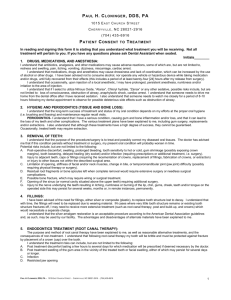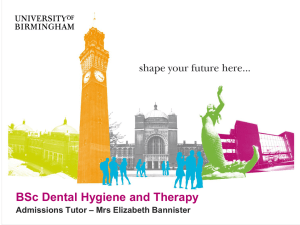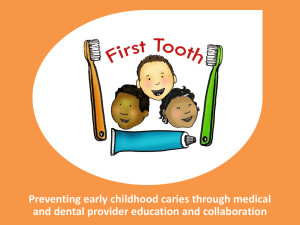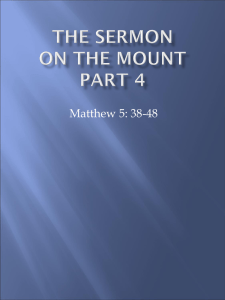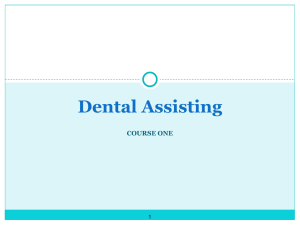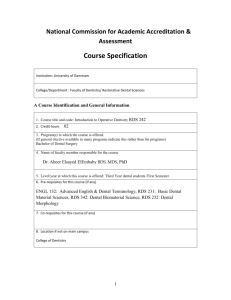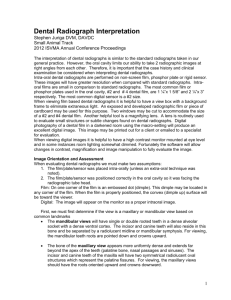Regenerative Dentistry: Where are we headed now?
advertisement
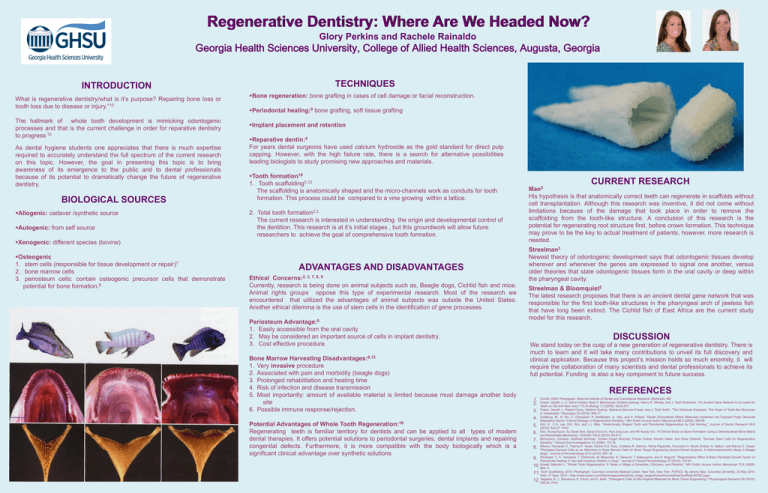
Regenerative Dentistry: Where Are We Headed Now? Glory Perkins and Rachele Rainaldo Georgia Health Sciences University, College of Allied Health Sciences, Augusta, Georgia INTRODUCTION What is regenerative dentistry/what is it’s purpose? Repairing bone loss or tooth loss due to disease or injury.”10 The hallmark of whole tooth development is mimicking odontogenic processes and that is the current challenge in order for reparative dentistry to progress.10 As dental hygiene students one appreciates that there is much expertise required to accurately understand the full spectrum of the current research on this topic. However, the goal in presenting this topic is to bring awareness of its emergence to the public and to dental professionals because of its potential to dramatically change the future of regenerative dentistry. BIOLOGICAL SOURCES Allogenic: cadaver /synthetic source Autogenic: from self source TECHNIQUES Bone regeneration: bone grafting in cases of cell damage or facial reconstruction. Periodontal healing:9 bone grafting, soft tissue grafting Implant placement and retention Reparative dentin:4 For years dental surgeons have used calcium hydroxide as the gold standard for direct pulp capping. However, with the high failure rate, there is a search for alternative possibilities leading biologists to study promising new approaches and materials. Tooth formation10 1. Tooth scaffolding5,12 The scaffolding is anatomically shaped and the micro-channels work as conduits for tooth formation. This process could be compared to a vine growing within a lattice. 2. Total tooth formation2,3 The current research is interested in understanding the origin and developmental control of the dentition. This research is at it’s initial stages , but this groundwork will allow future researchers to achieve the goal of comprehensive tooth formation. Xenogenic: different species (bovine) Osteogenic 1. stem cells (responsible for tissue development or repair)7 2. bone marrow cells 3. periosteum cells: contain osteogenic precursor cells that demonstrate potential for bone formation.8 ADVANTAGES AND DISADVANTAGES Ethical Concerns:2, 3, 7, 8, 9 Currently, research is being done on animal subjects such as, Beagle dogs, Cichlid fish and mice. Animal rights groups oppose this type of experimental research. Most of the research we encountered that utilized the advantages of animal subjects was outside the United States. Another ethical dilemma is the use of stem cells in the identification of gene processes. Periosteum Advantage:8 1. Easily accessible from the oral cavity 2. May be considered an important source of cells in implant dentistry. 3. Cost effective procedure. Bone Marrow Harvesting Disadvantages:8,12 1. Very invasive procedure 2. Associated with pain and morbidity (beagle dogs) 3. Prolonged rehabilitation and healing time 4. Risk of infection and disease transmission 5. Most importantly: amount of available material is limited because must damage another body site 6. Possible immune response/rejection. Potential Advantages of Whole Tooth Regeneration:10 Regenerating teeth is familiar territory for dentists and can be applied to all types of modern dental therapies. It offers potential solutions to periodontal surgeries, dental implants and repairing congenital defects. Furthermore, it is more compatible with the body biologically which is a significant clinical advantage over synthetic solutions CURRENT RESEARCH Mao5 His hypothesis is that anatomically correct teeth can regenerate in scaffolds without cell transplantation. Although this research was inventive, it did not come without limitations because of the damage that took place in order to remove the scaffolding from the tooth-like structure. A conclusion of this research is the potential for regenerating root structure first, before crown formation. This technique may prove to be the key to actual treatment of patients, however, more research is needed. Streelman3 Newest theory of odontogenic development says that odontogenic tissues develop wherever and whenever the genes are expressed to signal one another, versus older theories that state odontogenic tissues form in the oral cavity or deep within the pharyngeal cavity. Streelman & Bloomquist2 The latest research proposes that there is an ancient dental gene network that was responsible for the first tooth-like structures in the pharyngeal arch of jawless fish that have long been extinct. The Cichlid fish of East Africa are the current study model for this research. DISCUSSION We stand today on the cusp of a new generation of regenerative dentistry. There is much to learn and it will take many contributions to unveil its full discovery and clinical application. Because this project’s mission holds so much enormity, it will require the collaboration of many scientists and dental professionals to achieve its full potential. Funding is also a key component to future success. REFERENCES Cichlid. 2009. Photograph. National Institute of Dental and Crainiofacial Research, Bethesda, MD Fraser, Gareth J., C. Darrin Hulsey, Ryan F. Bloomquist, Kristine Uyesugi, Nancy R. Manley, and J. Todd Streelman. "An Ancient Gene Network Is Co-opted for Teeth on Old and New Jaws." PLoS Biology 7.2 (2009): 0233-247. Gareth J., Robert Cerny, Vladimir Soukup, Marianne Bronner-Fraser, and J. Todd Smith. "The Odontode Explosion: The Origin of Tooth-like Structures 3. Fraser, in Vertebrates." Bioessays 32 (2010): 808-17. M., N. Six, C. Chaussain, P. DenBesten, A. Veis, and A. Poliard. "Dentin Extracellular Matrix Molecules Implanted into Exposed Pulps Generate 4. Goldburg, Reparative Dentin: A Novel Stratagy in Regenerative Dentistry." NIH Public Access Author Manuscript 88.5 (2009): 396-99. K., C.H. Lee, B.K. Kim, and J.J. Mao. "Anatomically Shaped Tooth and Periodontal Regeneration by Cell Homing." Journal of Dental Research 89.8 5. Kim, (2010): 842-47. Print. Young-Kyum, Su-Gwan Kim, Sung-Chul Lim, Hyo-Jung Lee, and Pil-Young Yun. "A Clinical Study on Bone Formation Using a Demineralized Bone Matrix 6. Kim, and Resorbable Membrane." OOOOE 109.6 (2010): E6-E11. Christian, Gottfried Schmalz, Torsten Eugen Reichert, Florian Vollner, Kerstin Galler, and Oliver Driemel. "Somatic Stem Cells for Regenerative 7. Morsczeck, Dentistry." Clinical Oral Investigations 12 (2008): 113-18. Fernando V., Fabrica F. Suaid, Karina G.S. Ruiz, Cristiane R. Salmon, Telma Paparotto, Francisco H. Nociti, Enilson A. Sallum, and Marcio Z. Casati. 8. Ribeiro, "Periostem-Derived Cells as an Alternitive to Bone Marrow Cells for Bone Tissue Engineering Around Dental Implants. A Histomorphometric Study in Beagle Dogs." Journal of Periodontology 81.6 (2010): 907-16. Y., K. Taniyama, T. Yoshimoto, M. Miyamoto, N. Takeuchi, T. Matsuyama, and K. Noguchi. "Regenerative Effect of Basic Fibroblast Growth Factor on 9. Shirakata, Periodontal Healing in Two-wall Intrabony Defects in Dogs." Journal of Clinical Periodontology 37 (2010): 374-81. Malcolm L. "Whole Tooth Regeneration: It Takes a Village of Scientists, Clinicians, and Patients." NIH Public Access Author Manuscript 72.8 (2008): 10. Snead, 903-11. 11. Tooth Scaffolding. 2010. Photograph. Columbia University Medical Center, New York, New York. POPSCI. By Jeremy Mao. Columbia University, 25 May 2010. Web. 27 Sept. 2010. <http://www.popsci.com/files/imagecache/article_image_large/articles/HumanMolarScaffoldLARGE2.jpg>. B., L. Bacakova, E. Filova, and K. Balik. "Osteogenic Cells on Bio-Inspired Materials for Bone Tissue Engineering." Physiological Research 59 (2010): 12. Vagaska, 309-22. Print. 1. 2.



